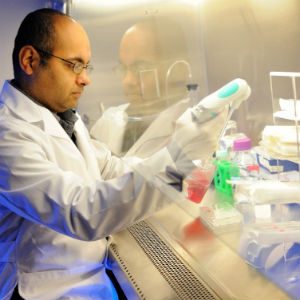
Scientists at the Virginia Tech Carilion Research Institute discovered how mutations of a gene called CASK may cause genetic disorders such as microcephaly and postnatal intellectual disabilities.
The research team, led by Assistant Professor Konark Mukherjee, found that when the CASK gene is deleted from cells, the cells have a shorter lifespan but more importantly they affect the health of normal cells around them.
“We found evidence that the CASK plays a role in regulating brain growth,” Mukherjee said. “A mutated CASK gene can lead to atrophy, even in neighboring brain cells without the mutation.”
Mukherjee and his team published the results from two studies in Cellular and Molecular Life Sciences and in Acta Neuropathologica Communications. The results, found in mouse models for human brain disorders, suggest a potential therapeutic target for interventions to possibly to prevent abnormalities associated with CASK gene mutations, such as autistic traits, intellectual disabilities, and Ohtahara syndrome.
The findings also shed light on microcephaly, a condition in which improper development results in an abnormally small brain and head. The condition has become more commonly known recently because of its association with contraction of Zika virus by pregnant women.
CASK proteins, which are produced by expression of the CASK genes, pull in other proteins to form a larger complex. But CASK genes can be genetically mutated and give rise to CASK proteins with altered structure and function. Those proteins don’t communicate properly, and they can lead to abnormal formation and function of synaptic connections between developing neurons and other effects on metabolism in the immature brain, contributing to intellectual disability and disorders such as microcephaly, disproportionate pontine, and cerebellar hypoplasia syndrome.
Funded in part by the National Eye Institute of the National Institutes of Health, Mukherjee and his team examined rodents engineered without functional CASK genes, expecting to see the same sort of pathologies that result from mutated CASK proteins.
“We actually found that microcephaly, disproportionate pontine, and cerebellar hypoplasia syndrome is not purely neuronal in origin, although it’s clear that a lack of neuronal CASK function contributes to a spectrum of disorders,” Mukherjee said. He noted that rodents with CASK mutations also showed defects in brain metabolism — the brain’s ability to efficiently create energy from sugar.
The disproportionate cerebellar hypoplasia appears to be a matter of timing.
“Microcephaly, disproportionate pontine, and cerebellar hypoplasia syndrome have a major postnatal component,” Mukherjee said. “Our study provides evidence that the CASK gene regulates brain growth after birth, and that it conducts regulation in other cells, as well.”
The process by which the CASK gene regulates brain growth may be the key to preventing abnormal growth. Mukherjee said he doesn’t have the answer yet, but he’s on his way to understanding the role of CASK in brain growth regulation. It has to do with interactions with other proteins.
CASK proteins interact with three other proteins that are localized in the front end of the synaptic communication points between neurons — the presynaptic site. Like eggs, flour, and milk need to be mixed and heated to make a cake, CASK pulls together and arranges the other proteins. Mukherjee and his team propose that the CASK protein plays a critical structural role to link some of these proteins in a way that sends the correct chemical signals needs for signaling from the presynaptic site to the postsynaptic site, allowing effective cellular communication.
The environment appears to regulate the interactions of the CASK complex. An increase in certain ions, such as calcium or magnesium, encourages the proteins to join together and help control the chemical signals neurons send to one another across synapses. A mutated CASK protein prevents this type of regulation and may result in abnormal brain growth and intellectual disability.
“This is a strong first step in understanding how the proteins work together to adjust the chemical communication in the brain, and how that might affect brain growth,” Mukherjee said.










